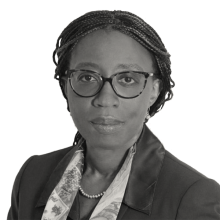
Sébastien Thibault for FP Analytics
In her decades-long career, Dr. Vera Songwe has seen firsthand the importance of tackling the global debt crisis not with a single tool but with different instruments tailored to each specific economy’s challenges—and the importance of knowing how to pivot when those instruments are not working. She recently championed work on the need to differentiate between liquidity-constrained economies and insolvent economies—also known as the bridge proposal. The G20, in coordination with the World Bank and International Monetary Fund (IMF), is developing this approach further within a three-pillar framework.
In a wide-ranging conversation with FP Analytics, Dr. Songwe talked about models for debt reform that are showing promise, how debt relief can facilitate development, and why it’s essential that climate and nature be infused into any debt sustainability analysis. The following transcript has been edited for length and clarity.
FP Analytics (FPA): What is the most urgent debt challenge that needs immediate attention today, and which countries or regions do you think are most affected?
Vera Songwe (VS): Many countries—from Southeast Asia to Latin America and Africa—contracted low-cost debts a decade ago, with variable interest rates, and a lot of these are coming due at a time when global growth has contracted substantially and because inflation rates have increased three fold. This is happening at a time principal payments are coming due as well. Countries are faced with stiff debt service obligations. Countries do not have the resources needed to refinance their debt, and the cost of refinancing is high. It’s a very difficult financing environment, but it’s also a very difficult growth environment. Countries are being squeezed from both ends. Many of the projects developed during this period have not yet reached a stage where they’re delivering returns; it takes on average 10, 15 years to get an energy project developed and making profits with which to repay the initial debt. While it should be clear that most of debt contracted was used efficiently, of course, there is no denying there was some misuse.
FPA: How can debt relief and reform facilitate sustainable development, particularly for climate adaptation and mitigation, public health, education, and other global public goods?
VS: What debt relief does is it creates additional fiscal space for countries to invest in growth-inducing activity. It provides countries with additional revenue to be able to do development. Today, many countries are spending 3 to 5 percent of their gross domestic product (GDP) to pay for debt service, which means that they’re spending more on debt than on health, education, and investment combined. If you’re not investing in new infrastructure and creating new assets, you’re hardly growing. And so if we go through five years where all that countries are doing is paying their debt and taking care of recurrent expenditures—which means salaries and pensions and defense—then what we end up with is low growth. Debt relief in the medium term also brings down the cost of borrowing, improves a country’s rating, and crowds in more private investment. With additional private investment, the public sector can then focus on investment in public goods and climate adaptation projects.
FPA: Are there any potential models for debt reform or relief that you see as particularly promising, especially in the context of climate finance? If so, what are these models?
VS: There are a number of suggestions that are discussed by the Expert Review on Debt, Nature, and Climate in a report I was privileged to co-chair with Moritz Kraemer—Healthy Debt on a Healthy Planet—where we suggest a number of alternatives or pathways for getting a debt framework in place. First, we recommend improving the IMF and World Bank Debt Sustainability Framework to better incorporate both climate-related and nature-related risks and the economic benefits of measures to reduce them. This will allow for a more accurate measure of countries’ debt tolerance and provide adequate measures to address them. Second, for countries facing solvency issues that need debt restructuring, additional debt relief should be available in return for binding nature- and climate-related commitments that will enhance resilience and stimulate growth. For countries facing liquidity issues—those with high debt-service obligations but not yet in a debt crisis—debt refinancing should be available to enable nature- and climate-related investments as part of a comprehensive growth-inducing and debt-reducing package. The issuance of new climate-aligned special drawing rights is an example of how more liquidity could be injected into the system. Third, we propose a few solutions for averting financial distress as the frequency and severity of climate and nature shocks increase, such as asking creditors and debtors to agree on contingency clauses in debt contracts that offer protection against shocks and allow for the ability to defer repayments for an agreed-upon period while countries manage the shock. Other forms of debt relief could include scaling up debt-for-nature and debt-for-climate swaps and sustainability-linked financing. We recommend that multilateral development banks (MDBs) working with the Green Climate Fund develop standardized structures to make it easier and cheaper to deploy these instruments. Fourth, we propose unlocking private capital via new mechanisms and instruments—such as using guarantees and other forms of hybrid capital—to leverage more private-sector participation. Specifically, we call for the creation of a Finance Facility Against Climate Change. Finally, for all of these actions, more capacity-building is needed in countries and within international financial institutions to support the speed and scale of deployment. We just released The Jubilee Report, which also discusses many of these issues. The good news is that there is a rallying cry for action from many today about the need for reform of the global financial architecture.
FPA: Have these models been implemented in the past, or are they all completely new suggestions that haven’t been tested?
VS: The IMF and the World Bank are working on improving the Debt Sustainability Framework, but we believe more can be done, especially regarding the inclusion of both climate-related and nature-related risks and the economic impacts of measures to reduce them in the macro projections over the long term. The report calls for rapid improvements of the G20 Common Framework for debt resolution so that debt treatments can happen in a time-bound and more transparent and inclusive manner. Following the COVID-19 pandemic, the issuance of the debt-service suspension initiative by the G20 allowed for countries to use the liquidity freed up under the program to address urgent health concerns. The climate-resilient debt clauses are meant to do the same. Barbados has benefited from this, and the report calls for all MDBs as well as commercial creditors to adopt these clauses in their loan documents moving forward. There is an increasing number of debt swaps being developed. However, the product needs to be standardized and scaled to make a timely and important contribution to the global debt architecture. The IMF was able to allocate some of the on-loan special drawing rights from advanced economies into the Resilience and Sustainability Trust, working with countries to provide long-term, affordable financing for climate-aligned investments. More is needed, and in addition, other MDBs and regional development banks should be recipients of the special drawing rights. Debt treatment will only deliver growth if countries do not use all the fiscal space created to repay the private creditors and if access to new credit at cheaper rates is not available for market accessing countries.
FPA: At what point does a liquidity crisis become an insolvency crisis, and how can the leap to insolvency be prevented?
VS: Insolvency is when you can no longer pay your debt, when a country’s debt obligations exceed its revenues and assets. A liquidity crisis is when a country cannot honor its short-term obligations because it does not have the liquidity required in the short term. The best example I like to give about liquidity shocks—which can also create crises—is the Silicon Valley Bank (SVB). The SVB had in its account a hundred billion dollars of long-term Treasury bills, but it needed short-term liquidity to honor daily withdrawals from clients. It was not able to convert its long-term securities into short-term cash to be able to pay for its obligations. That’s a liquidity crisis. But if the liquidity crisis is not met, it becomes a solvency crisis. It is possible to prevent the liquidity crisis from becoming a solvency crisis by injecting short-term new liquidity into countries. But this must be associated with credible policy reform that demonstrates that countries can generate the long-term cash needed to honor their obligations going into the future. These can happen in a number of ways. The MDBs can provide additional capital to the countries, or markets can open allowing countries to issue new debt at affordable rates, as was the case for Côte d’Ivoire, for example. It is encouraging to see that, with support from the G20, the new IMF and World Bank Three Pillar Approach is meant to respond to this issue by supporting countries facing liquidity constraints to manage their way out of the squeeze.
FPA: What do you think are the evidence gaps that need to be addressed to further understand this topic and the impact of debt reform?
VS: It is important to be able to segment countries and treat them differently. Today, we say that more than 60 countries are in debt distress. But in reality, about a third of these countries are facing liquidity constraints. If we can split the universe of actions for those that are liquidity constrained and those that are insolvent, we have different solutions for them and immediately we are solving different problems. This also means releasing capital to deploy where it is needed most. We currently have a system where we administer the same medicine to many. If we don’t diagnose the problem correctly, if we are continuously treating the wrong problem, then of course it will keep reemerging because we are not treating it. If we’re able to work through the specific issues for the 20 LMICs that have liquidity constraints, provide a bridge back to growth, then we could relieve the pressures on the international community for additional resources and focus on the countries that do not have market access and have huge social needs.
Second, debt sustainability analyses should make sure climate and nature impacts are embedded into the analyses and help determine what resilience-building could do to improve macro stability. Current macroeconomic projections do not sufficiently embed the increasing and increasingly devastating climate impacts. With climate, when you have a hurricane or a huge climate disaster, it takes away 5 percent of your GDP, but the next year, you are not back to trend, because if you are Mozambique or if you’re Pakistan or if you are the south of Spain, you are still reconstructing. You haven’t six months later replanted soybeans and it’s all back again. No. You have lost critical infrastructure assets that could take more than five years to replace; there is no quick reversal to trend. And that’s why it’s very important to have climate and nature infused into the macroeconomic projections.
[In the Healthy Debt on a Healthy Planet report] we suggest something called the stock-flow consistent model, which is now being used by central banks in Europe, for example. It allows you to use an accounting-type model methodology to do forward-looking projections, because a lot of our macro projections make projections of the future based on the past, but climate events are not linear.
FPA: How can MDBs and other international financial institutions act more strategically to mobilize financing for development?
VS: Leverage. MDBs must use their low-cost, long-term resources to crowd in more market capital. Blended finance is the best way to deploy the diverse capital stack in the development space, but blended finance—if risks are not appropriately assigned—can be very counterproductive as even private sector risk is underwritten by the public sector. Capital must be allocated where it can most bear risk and crowd in other capital. In addition, MDBs may want to look into taking more equity positions. Today, MDBs are not mobilizing adequate external capital. Through the use of guarantees, first-loss, and subordinate instruments, they could do more. Second, we need better results and examples of success. I did a paper for the Center for Global Development on IDA [the World Bank’s International Development Association], where we show that not many countries have graduated from IDA in the past 15 years. Productivity is dropping in many countries, and growth has stalled. MDBs must make a better case to donors, demonstrating good successes to make a convincing story. Third, MDBs must also invest in new economy sectors, service sectors, and technology and artificial intelligence.
FPA: How can emerging economies, particularly those facing high levels of debt distress, coordinate more effectively to enhance their collective leverage in debt negotiations and global financial governance?
VS: This is critical. As a former head of the Economic Commission for Africa, what we were able to demonstrate was that when African finance ministers came together and called for specific solutions to their challenges, the G20 and MDBs listened. These solutions benefitted from robust analytical work to help guide suggested policy proposals. I think it is particularly important in these times of crisis that there are collective solutions to problems. Today, for example, there is a suggestion to create a debtor club. We’ve seen [Barbados Prime Minister] Mia Mottley pull together the coalition of small island development states (SIDS) and get debt-resilient pause clauses for SIDS. I think the lesson is clear: When you have coalitions that are consistent, that speak with one voice, that are based on analytical fact, it is easier to get the attention of policymakers, who find it very difficult to not feel the need to listen and act.
Dr. Vera Songwe is chair and founder of the Liquidity and Sustainability Facility, a visiting senior fellow at the Brookings Institution in the Global Economy and Development program, and co-chair of the Independent High-Level Expert Panel on Climate Finance. She was co-chair of the G20 Expert Group on climate, finance, and debt and co-chair of the Expert Review on Debt, Nature, and Climate. She is the former U.N. Under-Secretary General and Executive Secretary of the Economic Commission for Africa, the first woman to lead the organization in 60 years. Prior to that, she was a regional director at the International Finance Corporation and a country director at the World Bank.
More on Debt Architecture
Fixing Foreign Aid
Episode 1: How have the recent cuts in foreign aid impacted countries in the global south? And how did so many countries become reliant on foreign aid to begin with?
Tackling Sovereign Debt
Episode 2: How can we ensure countries looking to finance their future don’t have to mortgage away their present?
Reforming Global Finance
Episode 3: What can the World Bank and International Monetary Fund do to ensure more countries from the global south have a seat at the table?




